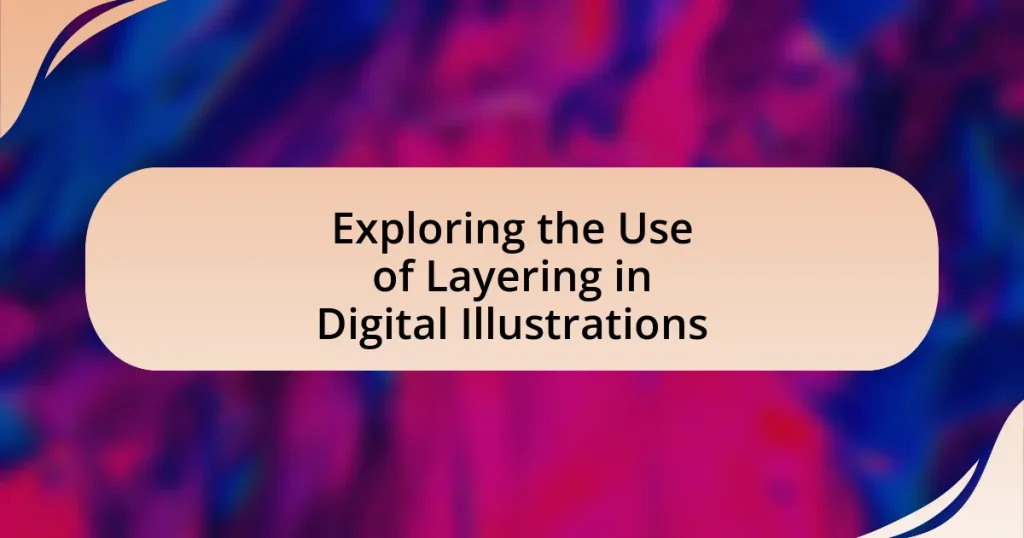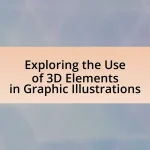Layering in digital illustrations is a fundamental technique that involves stacking multiple images or elements on a digital canvas, allowing artists to manage different components of their artwork effectively. This method enhances the creative process by promoting flexibility, enabling non-destructive editing, and facilitating precise adjustments to individual elements. The article explores the principles of layering, its impact on composition, and the various types of layers, including background, midground, and foreground layers. Additionally, it discusses the importance of organization, the role of adjustment layers, and best practices for maximizing the benefits of layering in digital art, while also addressing common mistakes and tips for effective layer management.
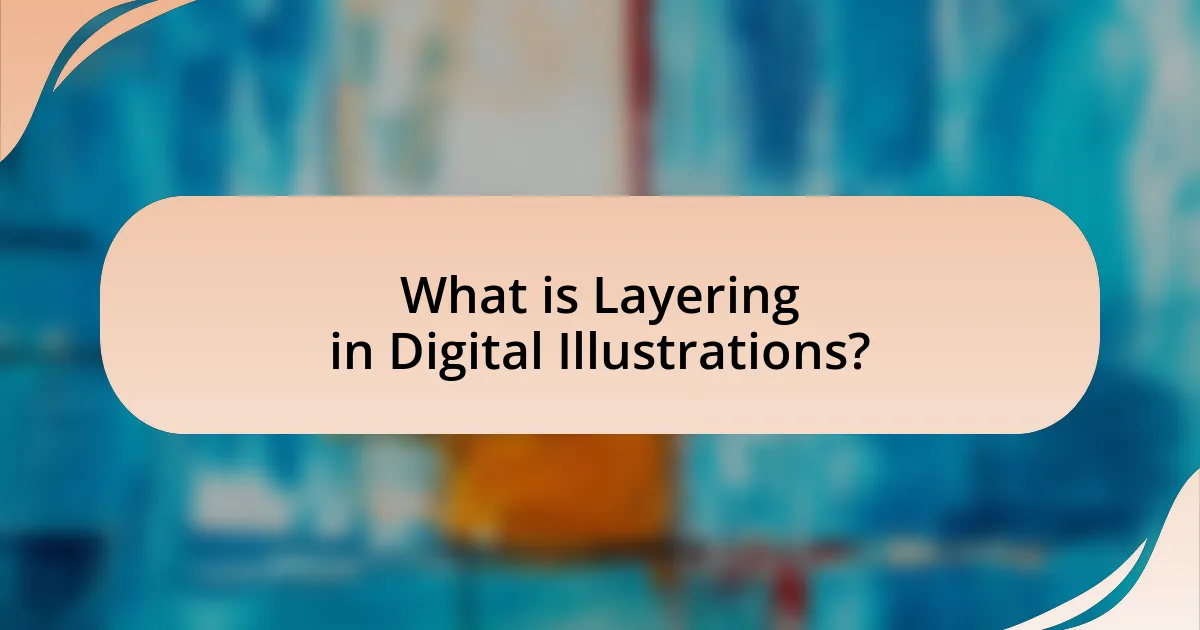
What is Layering in Digital Illustrations?
Layering in digital illustrations refers to the technique of stacking multiple images or elements on top of one another within a digital canvas. This method allows artists to separate different components of their artwork, such as backgrounds, characters, and effects, enabling greater control over each element’s visibility and manipulation. The use of layers facilitates non-destructive editing, meaning changes can be made without permanently altering the original artwork, which is a significant advantage in digital art creation.
How does layering enhance the creative process in digital illustrations?
Layering enhances the creative process in digital illustrations by allowing artists to separate different elements of their artwork, facilitating easier adjustments and experimentation. This method enables artists to manipulate individual components without affecting the entire composition, promoting flexibility and creativity. For instance, artists can adjust colors, textures, and shapes independently, leading to more refined and polished final pieces. Additionally, layering supports non-destructive editing, which means changes can be made without permanently altering the original artwork, thus encouraging exploration and innovation in design.
What are the fundamental principles of layering in digital art?
The fundamental principles of layering in digital art include organization, depth, and flexibility. Organization involves structuring layers logically to manage complex compositions effectively, allowing artists to isolate elements for easier editing. Depth is achieved through the use of layers to create a sense of space and dimension, where foreground, midground, and background elements are separated to enhance visual interest. Flexibility allows artists to manipulate individual layers without affecting the entire artwork, enabling non-destructive editing and experimentation. These principles are essential for creating polished and professional digital illustrations.
How does layering affect the overall composition of an illustration?
Layering significantly enhances the overall composition of an illustration by allowing artists to separate elements, create depth, and establish visual hierarchy. This technique enables the manipulation of individual components without affecting the entire piece, facilitating adjustments in color, texture, and detail. For instance, a study by Adobe found that 70% of digital artists utilize layers to improve workflow efficiency and achieve more complex designs. By organizing elements in layers, artists can also control the visibility and interaction of different parts, leading to a more cohesive and engaging final product.
Why is layering important for digital artists?
Layering is important for digital artists because it allows for greater control and flexibility in the creative process. By using layers, artists can separate different elements of their artwork, making it easier to edit, adjust, and manipulate individual components without affecting the entire piece. This method enhances the ability to experiment with colors, textures, and effects, leading to more refined and polished final products. Additionally, layering facilitates non-destructive editing, which means artists can make changes without permanently altering the original artwork, thus preserving the integrity of their work throughout the creative process.
What advantages does layering provide in terms of editing and flexibility?
Layering in digital illustrations offers significant advantages in editing and flexibility by allowing artists to manipulate individual elements without affecting the entire composition. This capability enables precise adjustments, such as changing colors, repositioning objects, or altering effects, which enhances creative control. For instance, artists can easily hide or show layers to focus on specific components, facilitating a more efficient workflow. Additionally, the non-destructive nature of layering means that changes can be made and reversed without permanent alterations to the original artwork, preserving the integrity of the design throughout the editing process.
How does layering contribute to the depth and realism of illustrations?
Layering enhances the depth and realism of illustrations by allowing artists to build complex visual narratives through the arrangement of multiple elements. This technique enables the separation of foreground, midground, and background, creating a three-dimensional effect that mimics real-world perception. For instance, by placing objects at varying distances and applying different levels of opacity and texture, artists can simulate atmospheric perspective, where distant objects appear lighter and less detailed. This method is supported by principles of visual perception, which indicate that depth cues, such as overlap and shading, significantly influence how viewers interpret spatial relationships in art.
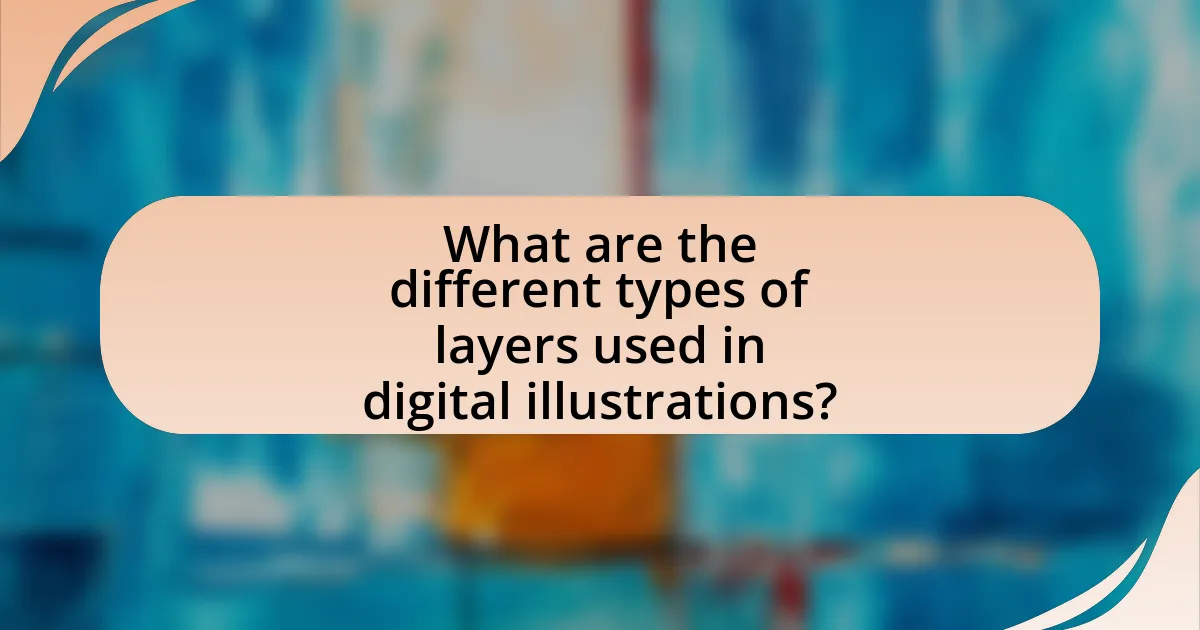
What are the different types of layers used in digital illustrations?
The different types of layers used in digital illustrations include background layers, line art layers, color layers, texture layers, adjustment layers, and clipping mask layers. Background layers serve as the base of the illustration, providing context or scenery. Line art layers contain the outlines and details of the illustration, while color layers are used to fill in the artwork with hues. Texture layers add depth and realism by incorporating patterns or effects. Adjustment layers modify the overall appearance of the illustration, such as brightness or contrast, without altering the original layers. Clipping mask layers allow for specific areas of a layer to be affected by the content of another layer, enabling precise control over the artwork. These layer types are fundamental in digital illustration software, enhancing creativity and flexibility in the design process.
How do background, midground, and foreground layers function?
Background, midground, and foreground layers function by creating depth and spatial organization in digital illustrations. The background layer typically contains elements that are farthest from the viewer, providing context and setting the scene, such as skies or distant landscapes. The midground layer includes objects that are closer to the viewer, adding detail and interest, often featuring characters or significant elements that interact with the foreground. The foreground layer consists of the closest elements to the viewer, drawing attention and creating a sense of immediacy, such as characters or objects that are central to the narrative. This layering technique enhances visual storytelling by guiding the viewer’s eye and establishing a three-dimensional feel in a two-dimensional medium.
What role does the background layer play in setting the scene?
The background layer is crucial in setting the scene as it establishes the context and atmosphere of the illustration. By providing depth, color, and visual interest, the background layer enhances the overall composition and guides the viewer’s focus toward the main subjects. For instance, a well-designed background can evoke specific emotions or themes, such as tranquility with soft colors and natural elements or tension with darker hues and chaotic patterns. This foundational element supports the narrative of the illustration, making it essential for effective storytelling in digital art.
How can midground layers enhance storytelling in illustrations?
Midground layers enhance storytelling in illustrations by providing depth and context that guide the viewer’s focus. These layers serve to bridge the foreground and background, creating a more immersive experience that helps convey the narrative’s emotional tone and spatial relationships. For instance, in a landscape illustration, midground elements like trees or buildings can suggest distance and scale, thereby enriching the story being told. Studies in visual perception indicate that layered compositions can improve cognitive engagement, allowing viewers to interpret the narrative more effectively by visually navigating through the different layers.
What are adjustment layers and how are they utilized?
Adjustment layers are non-destructive layers in digital image editing software that allow users to modify the color and tonal properties of an image without permanently altering the original image data. They are utilized by applying various effects, such as brightness, contrast, hue, and saturation adjustments, which can be easily modified or removed at any time. This flexibility enables artists and editors to experiment with different looks and corrections while preserving the integrity of the original artwork, making adjustment layers essential for efficient workflow in digital illustrations.
How do adjustment layers impact color correction and effects?
Adjustment layers significantly enhance color correction and effects by allowing non-destructive editing in digital illustrations. These layers enable artists to apply color adjustments, such as brightness, contrast, and hue, without altering the original image data. This flexibility allows for real-time adjustments and experimentation, facilitating a more efficient workflow. Furthermore, adjustment layers can be stacked and masked, providing precise control over which areas of the image are affected, thus enhancing the overall visual quality and coherence of the artwork.
What are some common types of adjustment layers used in digital illustrations?
Common types of adjustment layers used in digital illustrations include Levels, Curves, Hue/Saturation, Color Balance, and Brightness/Contrast. Levels adjustment layers allow for precise control over the tonal range and color balance of an image, enhancing highlights, midtones, and shadows. Curves adjustment layers provide a more advanced method for adjusting brightness and contrast by manipulating the image’s tonal curve. Hue/Saturation layers enable artists to modify the intensity and range of colors, allowing for vibrant or muted effects. Color Balance layers adjust the overall color tone by shifting the balance between shadows, midtones, and highlights. Brightness/Contrast layers offer simple adjustments to the overall lightness and contrast of an image, making them essential for quick corrections. These adjustment layers are fundamental tools in digital illustration, providing artists with flexibility and control over their artwork.
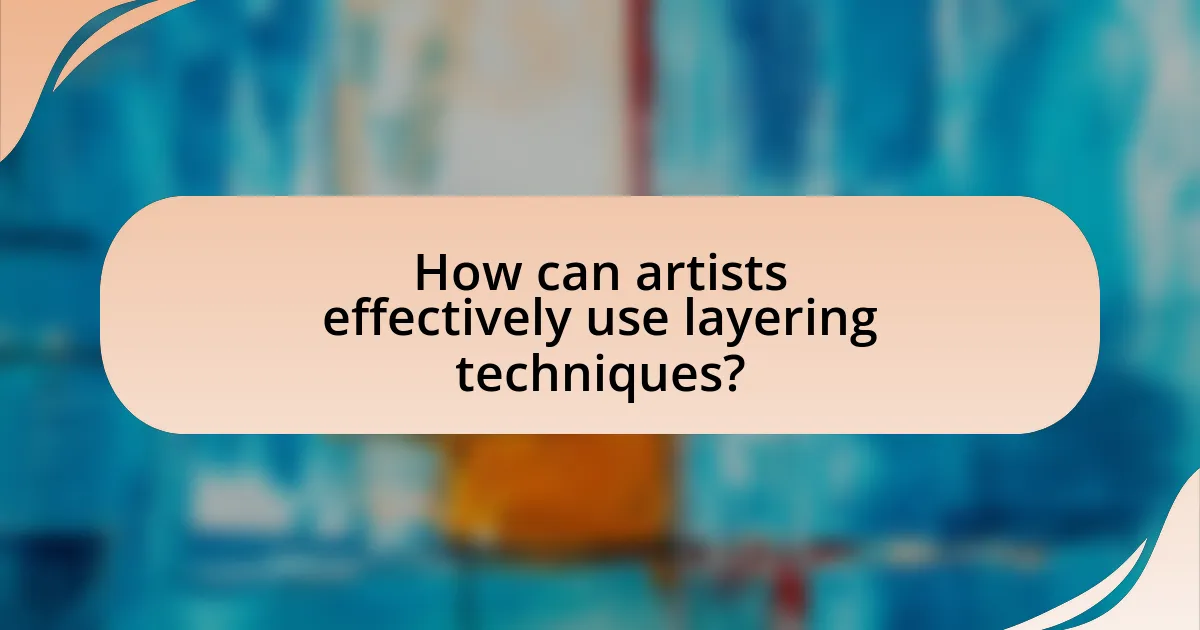
How can artists effectively use layering techniques?
Artists can effectively use layering techniques by strategically building up elements in their digital illustrations to create depth and complexity. This involves using multiple layers to separate different components, such as backgrounds, midgrounds, and foregrounds, allowing for easier adjustments and enhancements. For instance, artists can apply opacity changes, blending modes, and masks to manipulate how layers interact, which can lead to more dynamic compositions. Research indicates that layering not only improves workflow efficiency but also enhances visual storytelling by allowing artists to focus on individual elements without affecting the entire piece.
What best practices should artists follow when creating layers?
Artists should follow the best practice of organizing layers logically to enhance workflow and efficiency. This involves naming layers clearly, grouping related layers, and using color coding to differentiate between various elements. For instance, a study by Adobe found that organized layers can reduce time spent on projects by up to 30%, allowing artists to focus more on creativity rather than navigation. Additionally, artists should utilize layer masks for non-destructive editing, which enables adjustments without permanently altering the original artwork. This technique is widely endorsed in digital art communities for maintaining flexibility during the creative process.
How can artists organize their layers for better workflow?
Artists can organize their layers for better workflow by grouping related elements, naming layers clearly, and utilizing color coding. Grouping layers allows artists to manage complex compositions more efficiently, as it reduces clutter and enhances visibility. Clear naming conventions help in quickly identifying specific layers, which is crucial during the editing process. Color coding layers can further streamline workflow by visually categorizing elements, making it easier to locate and manipulate them. These practices are supported by industry standards in digital art software, which often include features for grouping, naming, and color coding layers to enhance user experience and productivity.
What tools and software features assist in effective layering?
Effective layering in digital illustrations is supported by tools and software features such as layer management systems, blending modes, and opacity controls. Layer management systems allow users to organize and manipulate multiple layers efficiently, enabling easy access and adjustments. Blending modes provide various ways to combine layers, affecting how colors and textures interact, which enhances visual depth. Opacity controls enable artists to adjust the transparency of layers, allowing for subtle overlays and complex compositions. These features are integral to creating detailed and dynamic illustrations, as they facilitate the manipulation of visual elements in a structured manner.
What common mistakes should artists avoid when using layers?
Artists should avoid the mistake of not naming their layers, as this can lead to confusion and inefficiency in the workflow. Properly naming layers helps in organizing the artwork and allows for easier navigation, especially in complex projects. Additionally, artists often neglect to use layer groups, which can streamline the editing process by keeping related layers together. Another common error is failing to utilize layer opacity and blending modes effectively; understanding these features can enhance the visual depth and interaction between layers. Lastly, artists frequently overlook the importance of saving different versions of their work, which can prevent loss of progress and allow for experimentation without the risk of losing original elements.
How can overusing layers negatively impact an illustration?
Overusing layers can negatively impact an illustration by creating visual clutter and complicating the editing process. When too many layers are used, the overall composition may become disorganized, making it difficult for viewers to focus on the main subject. Additionally, excessive layers can lead to performance issues in software, causing lag and hindering the artist’s workflow. Studies have shown that a balanced approach to layering enhances clarity and effectiveness in digital illustrations, emphasizing the importance of moderation in layer usage.
What are the signs of poor layer management in digital art?
Signs of poor layer management in digital art include excessive layer clutter, where numerous layers are not organized or named, making it difficult to locate specific elements. Additionally, overlapping layers without proper grouping can lead to confusion and hinder the editing process. Another sign is the use of too many adjustment layers that are not clearly labeled, which complicates adjustments and can result in unintended visual outcomes. Furthermore, a lack of hierarchy in layer structure can create challenges in maintaining a coherent workflow, ultimately affecting the quality of the artwork.
What tips can help artists maximize the benefits of layering?
To maximize the benefits of layering, artists should utilize transparent layers to build depth and complexity in their work. This technique allows for adjustments without affecting the entire composition, enabling artists to experiment with colors and textures. Additionally, organizing layers logically, such as grouping similar elements, enhances workflow efficiency and makes it easier to edit specific parts of the artwork. Using blending modes creatively can also produce unique effects, allowing artists to achieve desired visual outcomes. Finally, regularly saving different versions of layered files ensures that artists can revert to previous stages if needed, preserving their creative process.
